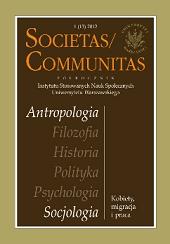Niebezpieczne związki? Płeć, rasa i seksualność w ramach teorii intersekcjonalności i teorii queer
Dangerous Liaisons? Gender, Race and Sexuality in Intersectionality and Queer Theory
Author(s): Joanna MizielińskaSubject(s): Social Sciences
Published by: Instytut Stosowanych Nauk Społecznych Uniwersytetu Warszawskiego
Keywords: gende; race; sexuality; lesbianism; critique of feminism; intersectionality; heteronormativity; queer theory
Summary/Abstract: The critique of feminism from the 80s and 90s has broadened feminism’s homogenised concept of gender identity and power relations and made it more complex, varied, and intertwined. Although the roots of intersectionality are strongly connected with the disagreement of non-white and non-middle class women with the feminist unified notion of domination, we should not forget about the similar critique from the 70s which was concerned with sexuality and lesbian invisibility. This first wave of criticism led to the notions such as “woman identified woman” or “lesbian continuum” which once again repudiated desire in the name of a common gender identity. It was precisely this repression of sexuality that was one of the elements that started the gay/straight split in the early 80s and brought about queer theory that challenges the notion of sexual identity and includes voices that were previously excluded. By definition, queer theory perceives all identities as contingent, shifting the knowledge/power relations. This creates conceptual and practical problems about the possible connections between those two theoretical approaches. Are intersectionality and queer theory interrelated? To which extent does one duplicate the other and how do they differ? Can we talk about queer intersectionality or about queering it (i.e. the question of heteronormativity)? Does queer theory analyze all power relations, or just some? In my text, I would like to reflect upon the history of the above-mentioned critique and its present consequences.
Journal: Societas/Communitas
- Issue Year: 2012
- Issue No: 13 (1)
- Page Range: 171-202
- Page Count: 32
- Language: Polish

